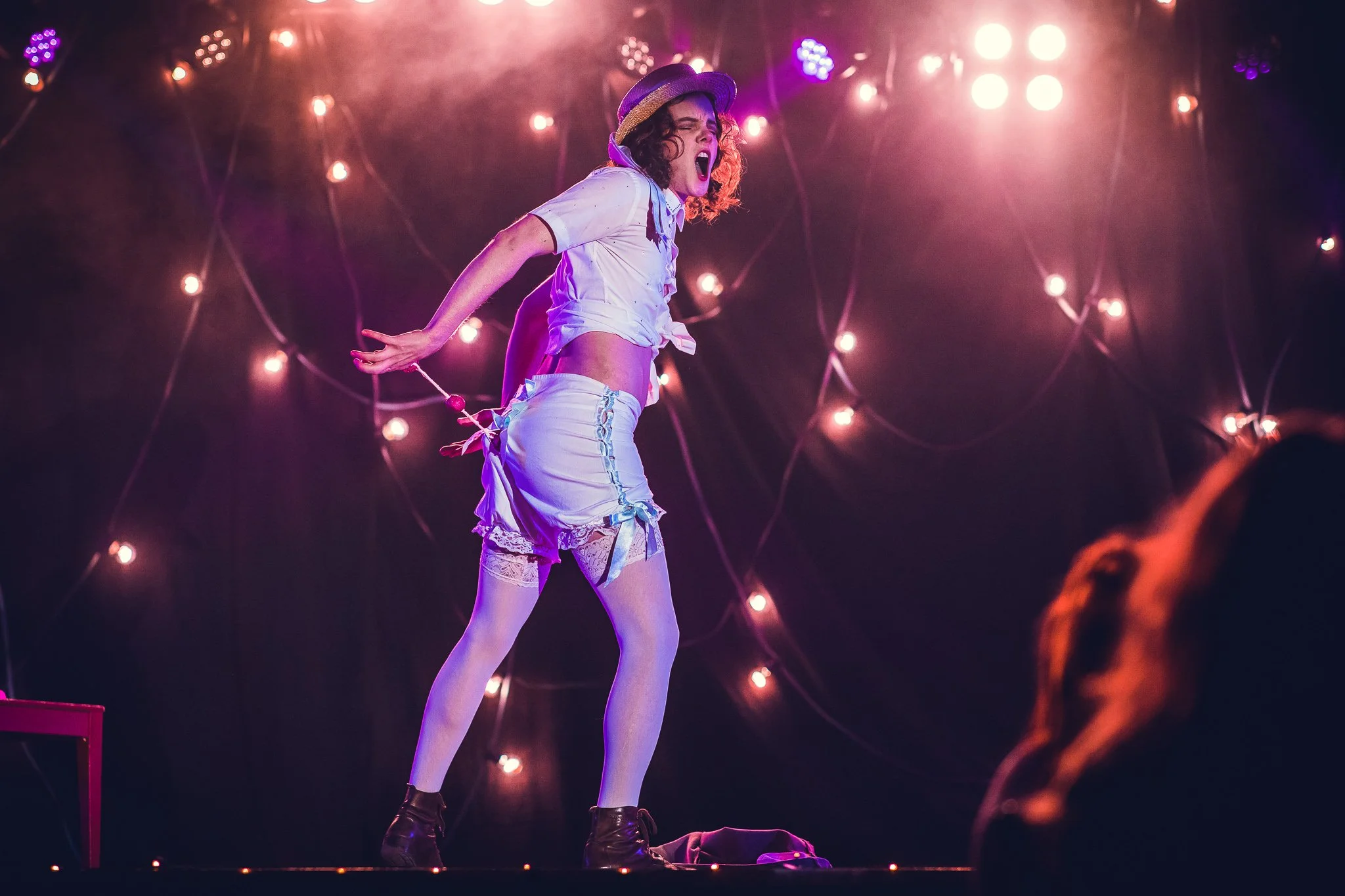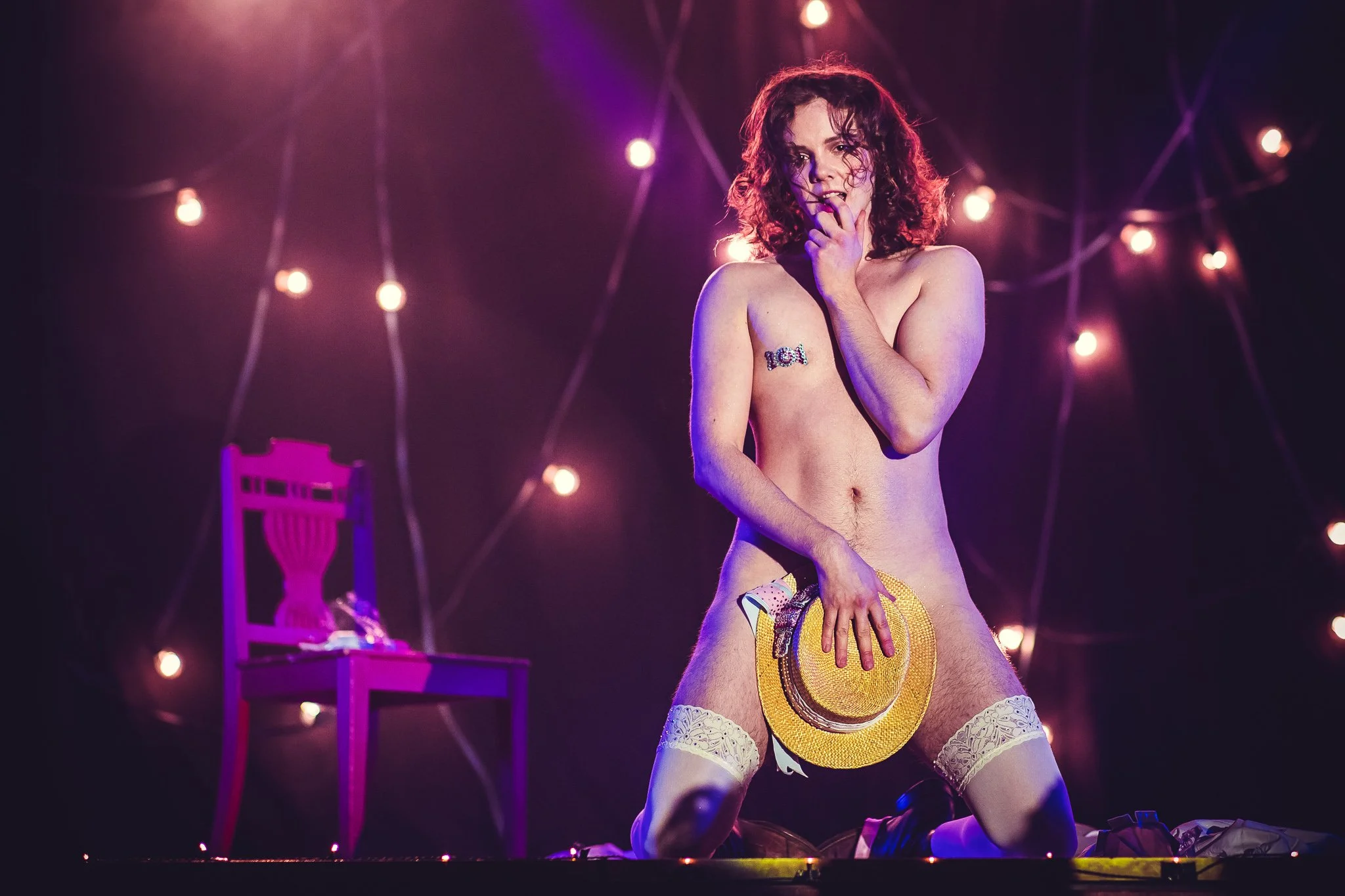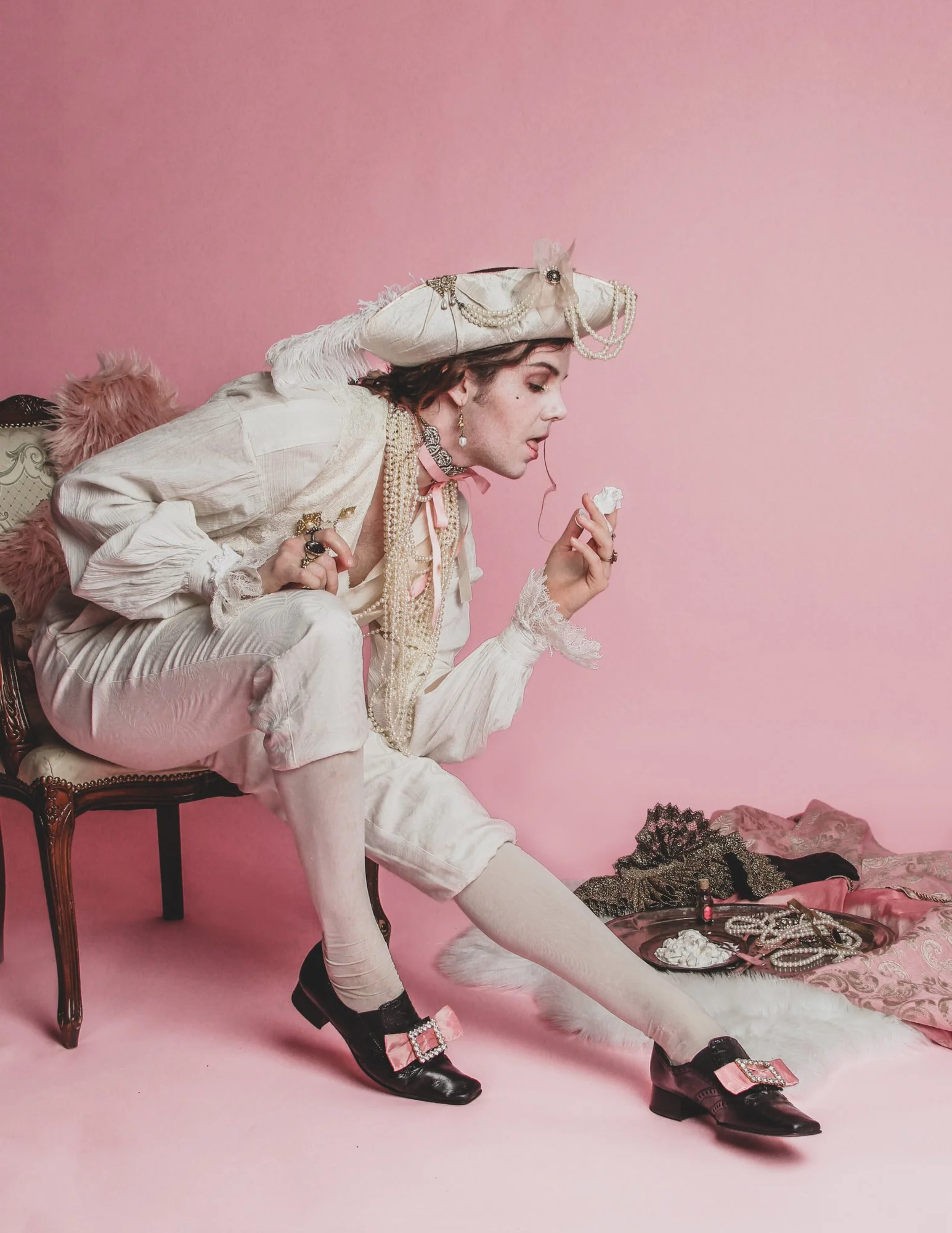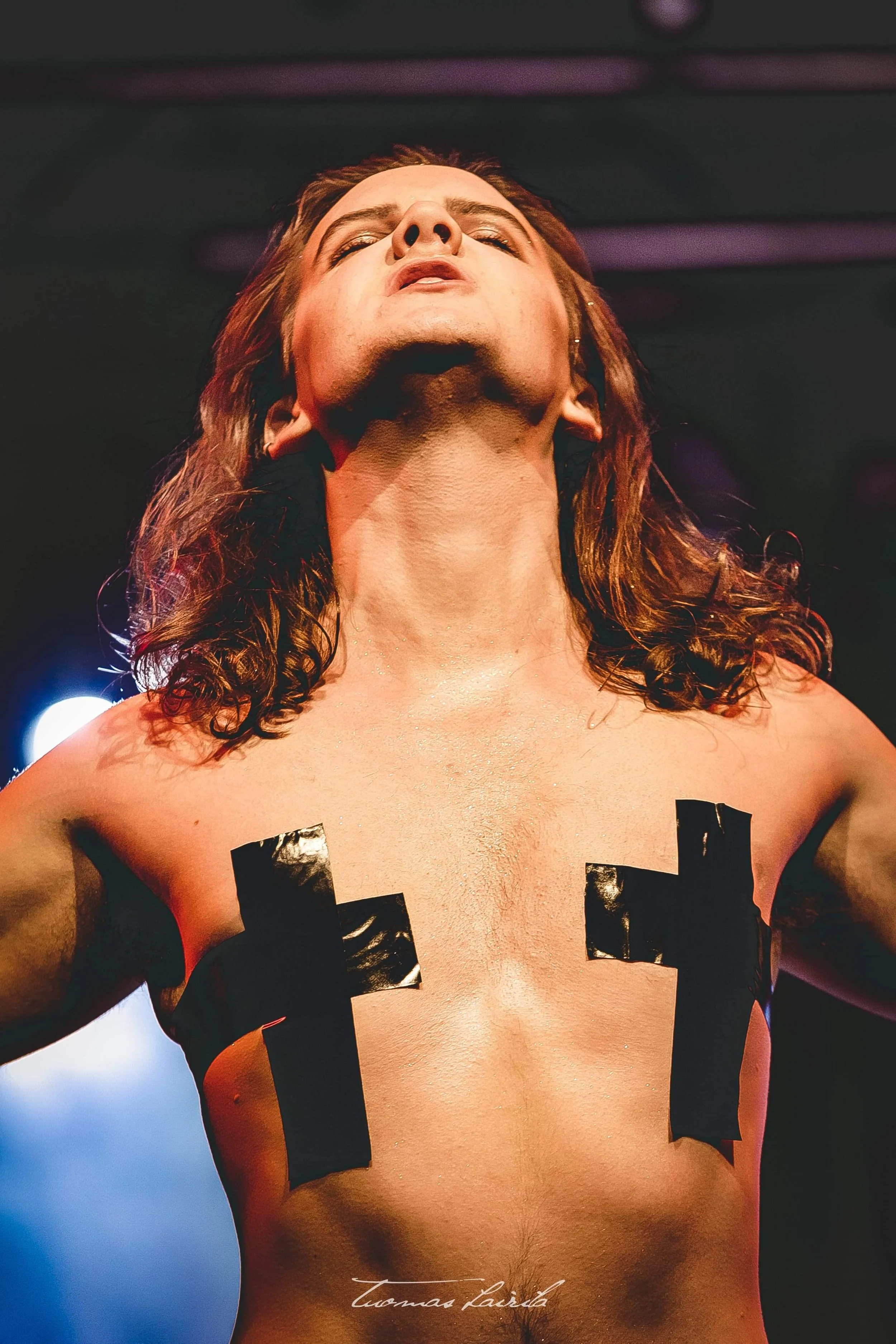Hasard Le Sin - Interview for Staging Decadence
Photo by Säde Puusa.
Hasard le Sin is a boylesque performer from Helsinki, Finland. His work experiments with alternative masculinities, and draws on myth, folklore, and fairytale. Beautifully crafted costuming is central in his practice. In Fairy Boudoir (or, Oberon Is Horny) (2019), he presented an antlered deity, crowned with golden leaves and robed in grey velvet, with gemstones dripping from a corseted body and pistil-like phalluses. Getting Biblical (2016) finds Hasard robed in clerical robes and collar, imploring his audience to ‘repent’ before being struck by some kind of divine inspiration, awakening to erotic sensuality and stripping to reveal Victorian undergarments and black crosses covering his nipples. In Hard Candy (2017) – his most controversial work, discussed below – he stages a male Lolita figure, lollipop in hand, and white stockings pulled up to the knees. He sucks on a stick of marshmallows while gazing furtively at the audience. In this interview for Staging Decadence, Hasard Le Sin discusses these works along with fourteenth-century sex workers, green carnations, and the danger of the decorative.
Could you paint us a picture of what the cabaret and burlesque scenes are like in Helsinki?
The scene is quite strange, and I say this in the most positive sense possible. Part of it is the fact that we have a burlesque scene that is quite closely connected to the drag scene, so you get a lot of overlap and collaboration. Then we also have a culture of nudity – sauna culture, essentially. The fact that someone is naked is not enough in and of itself. You’ve seen your friends naked, your parents naked, so it’s not as loaded as it is in other parts of the world. As a performer, that means you need to do more; you need to bring something else, which has led to a lot of creativity and storytelling, and a lot of people pushing the envelope in terms of strangeness and excess.
Also, even before the pandemic, a lot of the smaller venues shut down. So what we have are these club evenings that produce recurring events, but in different venues. I’ve performed in weird little bars, outdoor venues, and on the main stage of the national theatre – although that was a one-off! So the scene is very eclectic. Things can happen anywhere, but it’s also very precarious.
And what about the heritage of the Finnish scene? Who would you highlight as being particularly influential?
The grande dame of Finnish burlesque is someone called Bettie Blackheart, who brought neo-burlesque to Finland in the 1990s, right on the heels of the US revival exemplified by Dita Von Teese and people like that. There used to be a cabaret in Helsinki, if we go further back in history. The last permanent cabaret venue, The Red Windmill, closed its door in the 1960s – Moulin Rouge, basically, but in a Finnish translation. That one used to be frequented by the President when he was getting on in years, to escape from his apartment, which was just above the cabaret. So he would go downstairs and sneak in backstage. Apparently he was very popular with the performers, although not so much with the other staff! So we’re building on that, which was also influenced by the more international cabaret circuit of the early 1900s. The history of Finish burlesque is not separate from the rest of the world at that point. It draws on the same sources and people.
Bettie Blackheart performing her ‘wasp’ act at Alder Manor in New York in May 2017. You can also find recordings of nights at Pirate’s Pleasures on YouTube - a club run by Bettie Blackheart in Helsinki.
More recently, with the burlesque revival, there’s Bettie Blackheart, and in Tampere there’s Olivia Rouge. As personal inspirations I feel I should also mention Frank Doggenstein, Bent van der Bleu (also known by his drag alter ego Lola Vanilla), and the late, great Sir Willy Waterlily, whose performances first made me realize that burlesque is something I want to do. We definitely have an old guard to thank for the very vibrant, experimental scene we have today – especially Bettie Blackheart, who’s always had a very punk attitude toward doing burlesque. She ran the Helsinki Burlesque Festival for ten years. That was her creation. She also used to run these smaller clubs. One of them was called Pirate’s Pleasures, which was on a boat. It was very inconvenient because the ceiling was super low, and the whole thing moved a bit, which made it… interesting! She encouraged people to bring something that was raw, or a bit weird, or something that just wouldn’t get booked anywhere else. She also gave a lot of feedback, which really helped the scene to grow. There’s nothing wrong with full glamour vintage queen, which can be really wonderful and lovely. But because of Bettie’s punk background, we wound up with a lot of other things as well.
Where does boylesque fit into that?
Boylesque is burlesque done by people who are comfortable calling themselves boys, or a man, or burlesque that engages with masculinity somehow. The gender of the performer doesn’t necessarily have to enter into it. That’s how the term came about, but we’ve moved past that. Burlesque has always had queer undertones and overtones, but the connection is very visible in boylesque. I’m married to a non-binary person who sometimes presents quite femme. People assume, when I do boylesque, that I’m single. And then when they find out that I’m married, and they see the person that I’m married to, they say (shocked), ‘You’re straight?! But you do boylesque, so you’re gay, right?’ There are all these assumptions about boylesque, where you present male, and people think that you’re gay and available. I’ve been guilty of that myself! But there’s definitely this association between boylesque, queerness and gay culture, even if that isn’t the case for everyone. That connection exists in the cultural consciousness, and I think that has to do with its questioning of norms around gender and masculinity, and the assumption that the only people who would do this must be gay men. Let’s put it this way. My boylesque is inherently queer, but at the same time what I do isn’t drag. I’m not really interested in a binary gender performance, not that that’s all drag is or can be. I’ve been asked whether I’d perform drag queen stuff… It’s not my thing. I don’t know what that would look like, and I haven’t felt the pull towards that. I do have acts that play with gender and gender markers, but I like an ambiguity, and I like, aesthetically, either androgynous or mythological or historically-inspired acts. We know that things that were considered masculine 300 years ago are now consigned completely to the realm of femininity, like high heels or ostentatious jewellery, which would have been signs of power, wealth and status, or virility and masculinity. I want to look at that because I find it fascinating, and because the constraints of modern masculinity are suffocating and very boring!
Photo by Säde Puusa.
There’s a lot that I’d like to unpick there. Firstly, when you were saying that you don’t know what a conventional drag act would ‘look like’ for you… Where do you begin when making a new act? Does it begin with imagining what something will look like?
I do – it’s a very visual process. I often start with costume. Usually I have a theme, and then I figure out the narrative structure. Who is this person, what do they look like, what are they doing, why are they doing it? Of course, burlesque logic isn’t real-world logic. The ‘why’ doesn’t have to make real-world sense, but there has to be an internal logic. If I ask myself, ‘why am I taking my clothes off’, and the answer is, ‘because I do burlesque’ – well, that isn’t going to cut it! There needs to be something else. There needs to be a story, or some kind of transformation.
Can you give us an example? I’m thinking of Hard Candy (2017), for instance.
The candy act actually came about out of spite! Or annoyance. I started performing it in 2016, at which point I was 26, but I look younger than I am. My first act was Getting Biblical, and people started coming up to me after shows and saying, ‘oh, you know you were really good, but I couldn’t look at you because you’re, like, seventeen’. And it got less and less funny, until eventually I was like: Okay, you want jailbait… I’ll give you jailbait! People clearly delight in being shocked like that, so let’s give that to them then… Let’s go, but let’s go – properly, and on purpose. I wonder if I’d have the guts to make that act today. It’s designed to shame the audience, which is a bold move. Burlesque celebrates shamelessness, but that one is a Lolita take. You’re supposed to initially buy into the innocence as something alluring, as something where there’s the threat of it being somehow tainted, or ruined, or deflowered. That’s the bait. There’s an intro, there’s the music, a giant lollypop comes out and the music changes. There’s a snippet from a song with the lyrics: ‘ya’ll motherfuckers need Jesus’. And I turn and look straight at the audience, as if to say, ‘okay, are we going to do this? We’re going to do this!’. It starts with very explicit objectification, but it also plays with agency. When I do it well, there’s this sense of having been in charge all along. This happens by my say-so, according to rules that I set, which is generally true in burlesque. You objectify yourself on your own terms, which can be very liberating and empowering. But with the candy act… It started to annoy me, the degree of shock, with people thinking I’m so young. But we live in a culture where people routinely sexualise young women. We see it everywhere. The babydoll aesthetic is commonplace. But as soon as the person being objectified like that is male, then people lose their shit. I wanted to underscore that discrepancy a little bit, as this is someone we’re not used to seeing as a sexual object.
Photo by Teemu Nurminen.
Photo by Teemu Nurminen.
That plays into one of the reasons why I felt that there was something decadent going on in your work. It’s a twofold reason: appealing to a deliberate arousal of shame in the audience, which reminds me of how David Weir frames the decadent sensibility as the cultivation of a taste for the distasteful; and the ways in which your work keeps coming back to ideas of border-crossing, which others have suggested is key to decadence. Deliberately acknowledging distastefulness and luxuriating in it, and relishing practices of transgression – it’s in the meeting ground between those two things that lends your work to decadence I think.
Like you said, decadence tends to be about a taste for the distasteful, and in that there’s also a taste for excess. There’s a sense of immoral excess that I think is key to decadence, but the immorality is subjective. One of the things that drew me to burlesque, and that still remains part of the attraction, or that suggests that an act is good, is coming off stage with a sense of having gotten away with it. I want people to be scandalised, but I want them to still be delighted, especially the ones who may be shocked and surprised. It’s benevolent. It’s good business, because you want people to come back! But it’s also a means of questioning restrictions that we take for granted.
Burlesque doesn’t exist independently of mainstream culture, but it's also the kind of place where you can put unconventional bodies on stage and have them be unanimously celebrated. Bettie Blackheart and I – she’s in her 50s – we’ve talked a lot about age and sex appeal, and the kind of burlesque that people expect from her. Older women, and straight-presumed men, are all expected to do burlesque that is humorous, because surely the sexuality of these people is funny. There’s an underlying thought there that these people can’t or shouldn’t be genuinely sexy, or that these are bodies we should not desire. Putting bodies like that on a stage in front of people, and doing this sultry, intensely charismatic, genuinely sexy act that isn’t funny, or at least not at the expense of the performer – when people do an act like that it can have an immense impact. That’s part of the power of burlesque, where you can present an alternative reality that doesn’t care about the rules. It’s not breaking the rules by accident; it’s breaking the rules because you can, and getting away with it.
That’s maybe the positive side, but there’s another side too. I was talking with Alice Condé when I was in London for the Decadence @ Iklectik event that you and her organised [with Anjali Prashar-Savoie]. We were chatting about the fact that it’s easier to romanticise decadence in earlier periods than to romanticise the decadence that’s going on right now in the real world, which is too close to home. What kind of excesses do people go to – when talking about the excesses of the hyper rich for instance, which I find genuinely distasteful. There’s a line there, somewhere… I look at that, and the things that I find inspiring in history, and I wonder if the difference is really that big. But one of the things that I do find inspiring in history are those people who subvert social expectations. Yes, obviously Louis XIV was incredibly rich, but he also had a brother who regularly dressed up in ballgowns. I find the brother more interesting than the Sun King. Yes, he was probably also a horrible person! But burlesque is not the place for social realism. It’s a place for social commentary, and a site for the carnivalesque and escapism. That’s why I don’t really want to engage with real-world decadent excess, which comes with current injustice.
Hasard Le Sin performs Fairy Boudoir at ‘Decadence @ Iklectik’ (2022), co-produced by Staging Decadence, the British Association of Decadence Studies, and Anjali Prashar-Savoie. Iklectik Arts Lab, London. Photo by Emma Jones.
Where does ornamentation fit into that? Your fixation on the ornamental, if it’s fair to say that, has an aestheticist quality to it.
I’ve always been a maximalist. It’s a personal preference. I find cool Scandinavian minimalism boring. We often decorate things that we find valuable. We decorate things to convey value and importance. Decorating and adding ornament to things that are commonly treated with disdain, decorating a queer body… I put a lot of care and time into each act. It’s all handmade. Ostentation is frowned upon, but yes, I’m going to do this, and I’m going to make it beautiful! It's also related to gender, and assumptions around masculinity. There have been many times in history where decoration has been associated with men, but not so much today. I want to revel in that. It’s a queer reclamation. Part of being queer, and signalling queerness, often involves some kind of decoration – even at times when it's been very dangerous. There have been outward visual cues for those in the know. Think of green carnations, and seemingly innocuous decorative touches. I like to use references to that.
Photo by Säde Puusa.
Could you tell us more about that danger – the danger of the decorative?
When I think of decadence, I think of the marginalised subject. I think of a defiant exuberance in a world that does not readily permit it. I’m drawn to that. Are you familiar with late-fourteenth century queer history? There’s a figure in English legal history called John Rykener, who was also known as Eleanor Rykener. They were arrested for sodomy – publicly, at that – and for dressing as a woman. We have their confession records, and of course we don’t know how they extracted the confession, but they talk about being a sex worker in London and having sex with men both as a man and as a woman, as well as sex with women. Their preferred clients were members of the clergy, as they were nicer and paid better. There’s also someone by the same name escaping from prison a little later, although we don’t know if it’s the same person. There is a theory that suggests that this isn’t a real person at all, but a satire from the time: a political commentary on the relationship between the King and the Church, and the power that the Church wielded over the King. But the idea of someone existing in this way is not foreign to this time. They’re one of the figures I return to a lot… I want to do something with their story at some point, even if people have no idea who this person is. I’m sure that you could describe the life of this person as decadent in the sense that they were clearly someone who broke with convention, and some of the things that they did they clearly did for their own pleasure.
Doing something purely for pleasure is in a way decadent in its own right. We exist in a system of production where productivity becomes so prioritised that the idea of doing something for pleasure becomes indecent. I think burlesque, although it’s a job, is also something that I do for pleasure. There is a degree of decadence in that as well.
Photo by Tuomas Lairila.







